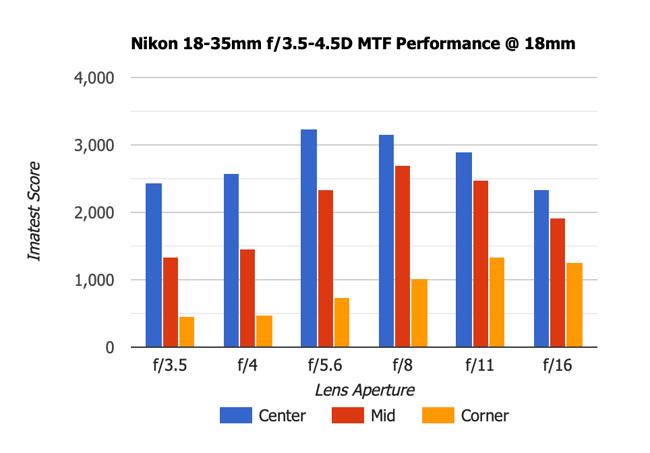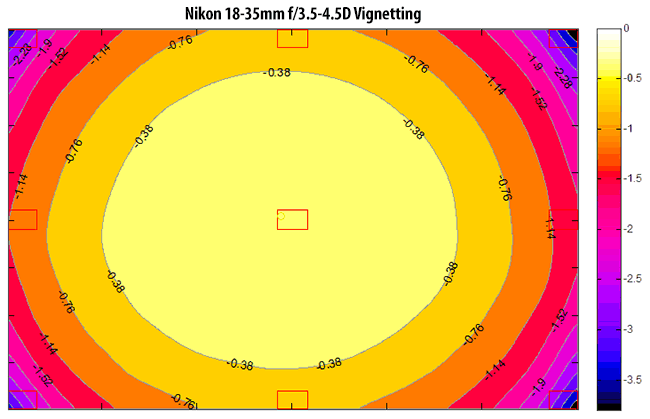Lens Sharpness, Contrast and Color Rendition
As I reveal below, the Nikon 18-35mm f/3.5-4.5D is far from being a stellar lens. Aside from a number of issues such as “wavy distortion”, chromatic aberration and heavy vignetting, the resolving power of the lens is very weak outside the center area, especially in the corners. The lens is so bad in the corners, that I would not consider using it on a full-frame body.
On APS-C / DX cameras, the lens does not look as bad, since the corners are not used and the performance in the corners looks similar to what we see in the mid-frame. Personally, I would rather use the excellent Nikon 16-85mm VR lens if I were looking for a DX lens in the same price range. I measured the MTF performance of the lens using Imatest software and so far this lens has been the worst performer for FX – see below for more information.

Nikon 18-35mm f/3.5-4.5D MTF Performance
Let’s take a look at the resolving capabilities of the Nikon 18-35mm f/3.5-4.5D in detail. Here is the lens performance at the short end of the zoom range, at 18mm:

The lens starts out pretty well and gets to very good performance at f/5.6 in the center. The mid-frame performance is much weaker than the center, but gets decent at f/5.6 and very good by f/8. Corner performance is very bad pretty much at all apertures, with its highest performance at f/11.
Here is the lens at 24mm:

The overall performance of the lens is slightly worse at 24mm. Center performance is weak wide open, but gets very good at f/8. Mid-frame performance drops compared to 18mm, with its peak performance at f/5.6-f/8. Corners still look pretty bad at all apertures.
And finally, here is the lens performance at 35mm:

Things look a little better at maximum aperture at 35mm, but the overall performance is still pretty weak across the frame.
Bokeh
Just like many other ultra wide-angle lenses, this lens is not really designed to yield beautiful bokeh, due to its small maximum aperture and short focal range, which results in large depth of field. At f/4.5, bokeh options at the longest focal length are still quite limited. You would have to get your subject extremely close to be able to get some subject isolation.
If you want to get better bokeh on wide angle lenses, try fast-aperture primes like Sigma 35mm f/1.4.

Vignetting
The Nikon 18-35mm f/3.5-4.5D suffers from heavy vignetting issues at 18mm. At f/3.5, vignetting is quite bad, reaching 2.79 EV in the corners. Take a look at the following chart, measured by Imatest:

Vignetting levels improve significantly at 24mm and are at the lowest level at 35mm.
And here is the illustration of the worst case scenario (18mm, f/3.5):

If you are planning to use a standard polarizing filter on this lens, it will vignette heavily in the corners at 18mm (corners will have to be cropped).
Ghosting and Flare
The lens can exhibit pretty nasty flare, depending on the position of the sun and aperture. Take a look at the following image sample, shot at f/8:

Take a look at the lower right corner of the frame – flare, strong in orange color is quite evident there. Ghosting is also pretty noticeable across the frame in tinted green and blue colors.
Distortion
While the Imatest charts below indicate pretty moderate levels of barrel distortion, the measured distortion levels are actually inaccurate, since this lens exhibits a very nasty case of curved or “wavy” distortion. First, take a look at the following graph charted by Imatest:

And now take a look at what the chart actually looked like when I photographed it at 18mm:

Take a look at the top line – ideally, the line should be straight, if a lens does not have any distortion. As you can see from the image, the line is not only curved, but it is irregularly curved – it first starts out flat, then starts curving at about 1/4th of the way, eventually taking a spherical shape, then it straightens back into a straight line again towards the end. This type of distortion is practically absent on modern lenses, but I have seen it a couple of times on older AF-D lenses.
The bad news, it is practically impossible to fix this type of distortion. If you try to fix distortion in the middle of the frame, the corners curve out, as shown in the “corrected” image below (+8 in Photoshop Lens Correction):

When the lens is used on APS-C cameras, the straight area is not in the frame, so distortion can be more or less fixed in Lightroom or Photoshop.
Also, pay attention to the lower line – this particular lens sample suffers from misaligned optical elements, so it is impossible to make both lines appear straight, or consistent. I have seen this on a number of lenses before, so it is not a rare occurrence, unfortunately.
Chromatic Aberration
Lateral chromatic aberration levels are high, averaging over 2 pixels at 18mm. CA levels drop down as you zoom in towards 35mm:

Lateral chromatic aberrations are generally not a problem and can be easily fixed in Lightroom and Photoshop. Longitudinal chromatic aberration is also under control, which is good news.
Next up, let’s look at a comparison with the newer version of this lens.
Table of Contents